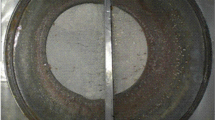Abstract
An experimental study of the thermally induced surface multiple cracking, on the example of steam superheater collector was carried out. The structure’s perforated area has 3 rows of holes, to which the connection sleeves are welded. On the first stage, the cracks initiate on the inner surface of the perforated area of the collector. These cracks are due to the thermal fatigue, caused by temperature changes at start-stops and by temperature fluctuations during operation. The histograms and cumulative distribution functions of crack lengths and the inclination angles with respect to the axes of fastening pipes holes were obtained. The length of most cracks was less than 2 mm. Also, an important localized damage on the collector inner surface in the form of a partly circumferential crack with a length of 149 mm and with the largest depth of 37.8 mm was observed.
Similar content being viewed by others
References
Taheri S. (2007) Some advances on understanding of high cycle thermal fatigue crazing. ASME Journal of Pressure Vessel Technology 129: 400–410
Kamaya M., Taheri S. (2008) A study on the evolution of crack networks under thermal fatigue loading. Nuclear Engineering and Design 238: 2147–2154
Purbolaksono J., Ahmad J., Beng L.C., Rashid R.Z., Khinani A., Ali A.A. (2010) Failure analysis on a primary superheater tube of a power plant. Engineering Failure Analysis 17: 158–167
Pronobis M., Wojnar W. (2012) The rate of corrosive wear in superheaters of boilers for supercritical parameters of steam. Engineering Failure Analysis 19: 1–12
Kryzhanivs’kyi E.I., Nykyforchyn H.M. (2011) Specific features of hydrogen-induced corrosion degradation of steels of gas and oil pipelines and oil storage reservoirs. Materials Science 47: 127–136
Yasniy P., Maruschak P., Lapusta Y., Hlado V., Baran D. (2008) Thermal fatigue material degradation of caster rolls’ surface layers Mechanics of Advanced Materials and Structures 15: 499–507
Park C.M., Choi J.T., Moon H.K., Park G.J, Park G.J (2009) Thermal crown analysis of the roll in the strip casting process. Journal of Materials Processing Technology 209: 3714–3723
Yasniy O., Maruschak P., Lapusta Y. (2011) Probabilistic modeling of surface crack growth in a roll of continuous casting machine International Journal of Fracture 172: 113–120
Yasniy, O., Lapusta, Y., Pyndus, Y., Sorochak, A., Yasniy, V. (2012). Assessment of lifetime of railway axle. International Journal of Fatigue http://dx.doi.org/10.1016/j.ijfatigue.2012.04.008 (in press).
Gorbatikh L., Kachanov M. (2000) A simple technique for constructing the full stress and displacement fields in elastic plates with multiple cracks. Engineering Fracture Mechanics 66: 51–63
Lapusta, Y. Henaff-Gardin, C. (2000). An analytical model for periodic ±º-layer cracking in composite laminates. International Journal of Fracture, 102, L73-76 (2000).
Loboda V., LapustaY. Sheveleva A. (2007) Electro-mechanical pre-fracture zones for an electrically permeable interface crack in a piezoelectric biomaterial. International Journal of Solids and Structures, 44: 5538–5553
Piat, R., Lapusta, Y., Böhlke, T., Guellali, M., Reznik, B., Gerthsen, D., Tengfei Chen, Oberacker, R., Hoffmann, M.J. (2007). Microstructure-induced thermal stresses in pyrolytic carbon matrices at temperatures up to 2900ºC. Journal of the European Ceramic Society, 27, 4813-4820.
Lapusta Y, Wagner W. (2001) On various material and fibre-matrix interface models in the near-surface instability problems for fibrous composites. Composites Part A: Applied Science and Manufacturing 32: 413–423
Brevus, V., Yasniy, O., Moutou Pitti, R., Lapusta, Y. (2012). Assessment of the probability of failure of reactor vessels after warm pre-stressing using Monte Carlo simulations . International Journal of Fracture. published 18 December. 2012, DOI:10.1007/s10704-012-9800-5
Stephan J-M., Curtit F., Vindeirinho C., Taheri S., Akamatsu M., Peniguel C. (2002) Evaluation of the risk of damage in mixing zones: EDF R&D programme. Proceedings Fatigue 1: 1707–1714
Maillot V., Fissolo A., Degallaix G., Degallaix S. (2005) Thermal fatigue crack networks parameters and stability: an experimental study. International Journal of Solids and Structures 42: 759–769
Anderson T.W., Darling D.A. (1954) A Test of Goodness of Fit. Journal of the American Statistical Association 49: 765–769
Varfolomeev I. V., Yasniy O. P. (2008) Modeling of fracture of cracked structural elements with the use of probabilistic methods. Materials Science 44: 87–96
Author information
Authors and Affiliations
Rights and permissions
About this article
Cite this article
Yasniy, V., Maruschak, P., Yasniy, O. et al. On Thermally Induced Multiple Cracking of a Surface: An Experimental Study. Int J Fract 181, 293–300 (2013). https://doi.org/10.1007/s10704-013-9826-3
Published:
Issue Date:
DOI: https://doi.org/10.1007/s10704-013-9826-3




